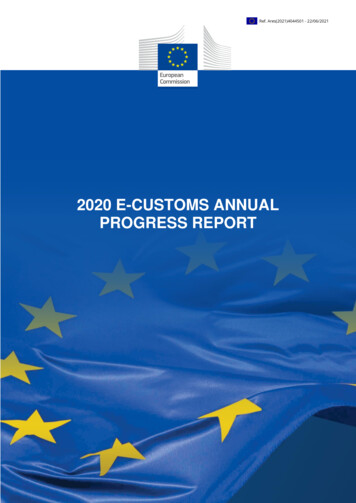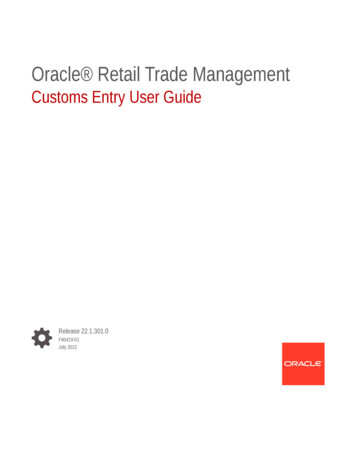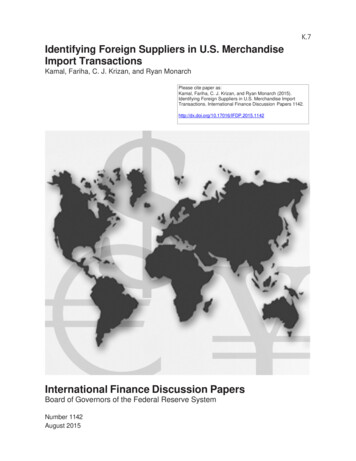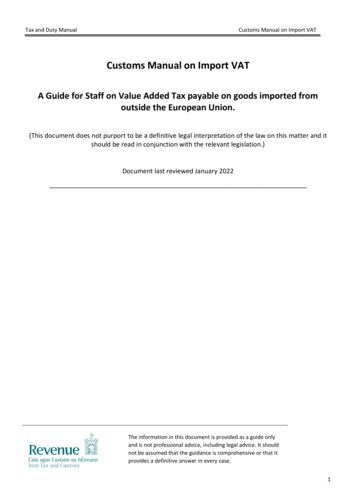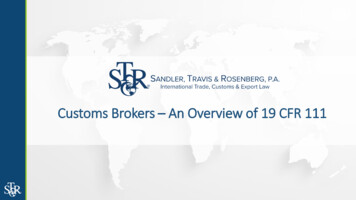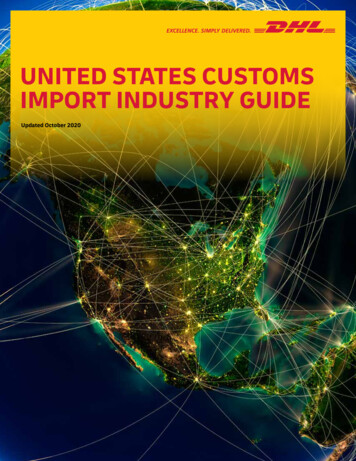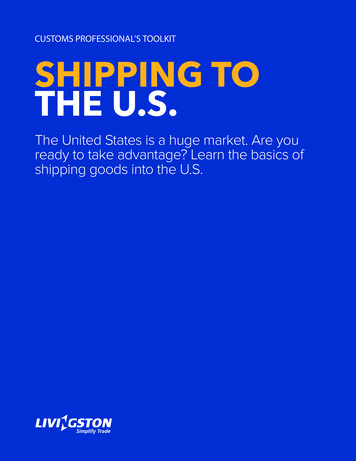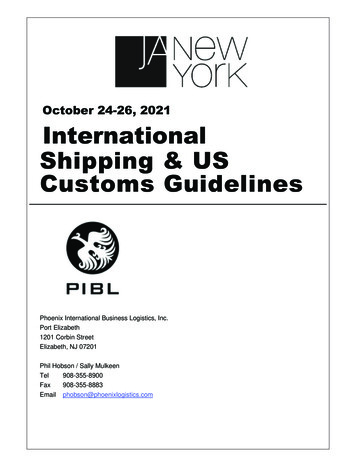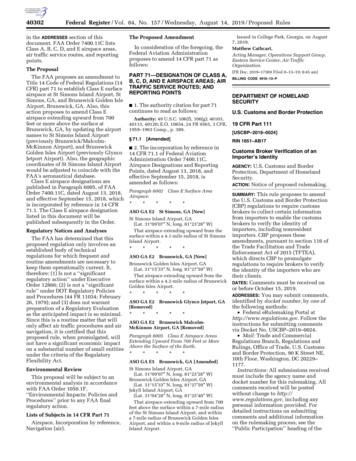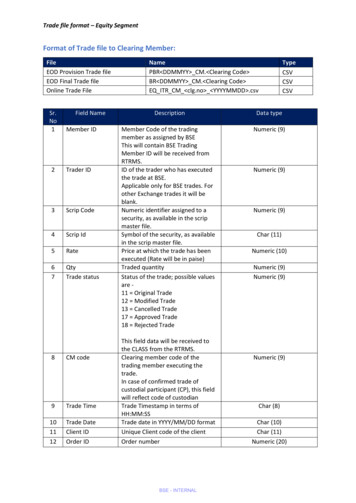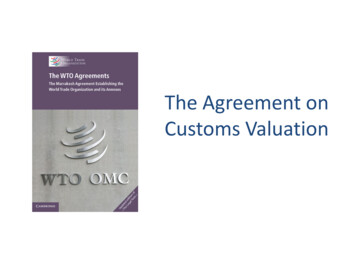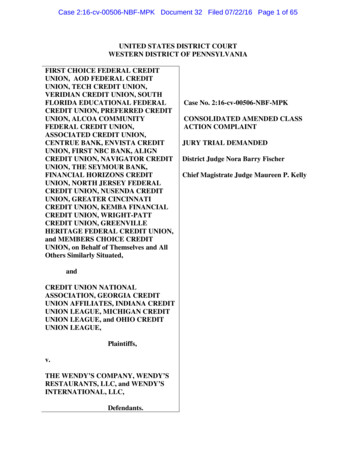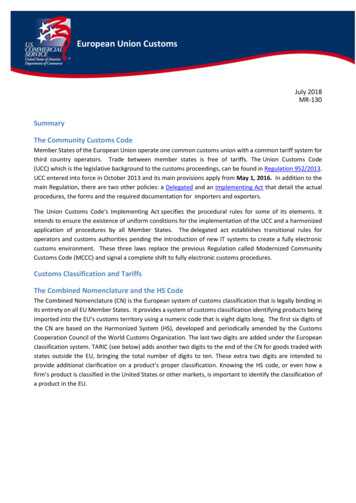
Transcription
1European Union CustomsJuly 2018MR-130SummaryThe Community Customs CodeMember States of the European Union operate one common customs union with a common tariff system forthird country operators. Trade between member states is free of tariffs. The Union Customs Code(UCC) which is the legislative background to the customs proceedings, can be found in Regulation 952/2013.UCC entered into force in October 2013 and its main provisions apply from May 1, 2016. In addition to themain Regulation, there are two other policies: a Delegated and an Implementing Act that detail the actualprocedures, the forms and the required documentation for importers and exporters.The Union Customs Code's Implementing Act specifies the procedural rules for some of its elements. Itintends to ensure the existence of uniform conditions for the implementation of the UCC and a harmonizedapplication of procedures by all Member States. The delegated act establishes transitional rules foroperators and customs authorities pending the introduction of new IT systems to create a fully electroniccustoms environment. These three laws replace the previous Regulation called Modernized CommunityCustoms Code (MCCC) and signal a complete shift to fully electronic customs procedures.Customs Classification and TariffsThe Combined Nomenclature and the HS CodeThe Combined Nomenclature (CN) is the European system of customs classification that is legally binding inits entirety on all EU Member States. It provides a system of customs classification identifying products beingimported into the EU’s customs territory using a numeric code that is eight digits long. The first six digits ofthe CN are based on the Harmonized System (HS), developed and periodically amended by the CustomsCooperation Council of the World Customs Organization. The last two digits are added under the Europeanclassification system. TARIC (see below) adds another two digits to the end of the CN for goods traded withstates outside the EU, bringing the total number of digits to ten. These extra two digits are intended toprovide additional clarification on a product’s proper classification. Knowing the HS code, or even how afirm’s product is classified in the United States or other markets, is important to identify the classification ofa product in the EU.
2TARICTARIC (“Tarif Intégré de la Communauté”) is the EU Integrated Tariff code. TARIC is directly binding on all EUMember States and duty rates are similar throughout the EU-28 1. It lays out the various rules applying tospecific products being imported into the EU Customs Union or, in some cases, applies to exports from theEU. TARIC identifies the duty to be assessed for each product classified under the CN, and any quotas or otherimport restrictions that may apply. Many EU Member States maintain a list of goods subject to importlicensing. TARIC can be searched by country of origin, HS code, or product description on the interactivewebsite of DG-TAXUD. The online TARIC is updated daily. The easiest way to determine if a product is subjectto restrictions is to check the TARIC using the CN code for that product and verify if specific codes such asCITES (Convention on International Trade and Endangered Species) or references to importsuspensions/restrictions are mentioned.Researching a Tariff Rate/Classification on TARIC1. Access the TARIC Homepage at:http://ec.europa.eu/taxation customs/dds2/taric/taric consultation.jsp?Lang en2. Search by CN Code or by using the other options under the advanced search option.3. For any questions on using this feature, consult the user manual at:http://ec.europa.eu/taxation customs/dds2/taric/help/dds user guide.pdf4. Restrictions and conditions that Member State customs authorities use to mitigate and recommendthe application of one classification over another are included in the Explanatory Notes, foundhere: https://ec.europa.eu/taxation nformation enBinding Tariff Information (BTI)A Binding Tariff Information (BTI) is a legally binding classification opinion that is issued by the customsauthority of an EU Member State. Under the Community Customs Code, a BTI issued by one Member Stateis legally binding on all other Member States. For a BTI to be legally binding, it must be invoked with eachand every import/export action. This can be done by making reference to the BTI on import documentationand by ensuring that distributors and agents are aware of its existence and use.A BTI is generally valid for 3 years, but in certain cases (e.g. the publication of a classification regulation or achange in the interpretation of the nomenclature at the international level), a BTI may cease to be valid. Itis worth noting that BTIs issued before May 2016 have a validity of 6 years. Relevant website:https://ec.europa.eu/taxation bti en )A company can influence the outcome of the classification opinion by discussing its case with the MemberState customs authorities) Companies are advised to consider all possible alternative classifications of theirproducts by researching classifications and tariff rates on the TARIC web page, and through the ExplanatoryNotes by researching any qualifications or conditions relevant for a given customs classification. TheNomenclature Committee (also called the Customs Code Committee) adjudicates differences in customsclassifications among Member States. See the “Customs Advocacy” section below for further information.1Value-Added Tax (VAT) rates apply in addition to duty rates but will differ from one Member State to another
3Duty ModificationsDuty Relief: The EU affords a few situations for duty relief as outlined in Regulation 1186/2009. In additionto personal property being imported duty free, educational, scientific and cultural materials may also beexempted. Annexes I through IV of the Regulation contain a detailed listing of exempted products. Nationalauthorities must approve entities engaged in scientific and/or educational research for eligibility to importgoods duty free.Tariff Suspensions: Once a good has received either a partial or total tariff suspension, it can freely movewithin the European Union. This explains why Member States are extensively consulted during discussionson possible suspensions. The rationale is economic stimulus; affected goods consist of raw materials, semifinished goods or components not available in the EU. No suspensions are granted for finished products. Norare suspensions granted when items are available in sufficient quantity within the EU or from third countrieswith GSP status (generalized system of preferences). Council Regulation 1378/2013 lists all affected productsin its Annex. Airworthiness – Customs duties for the import of parts, components and other goods used for aircrafthave been suspended on the basis of the conditions set in Council Regulation 581/2018. Military – Competent authorities within the Member States may procure weapons and militaryequipment free of import duties per Regulation 150/2003. The Regulation’s Annexes contain lists of affectedgoods.ATA (Admission Temporaire/Temporary Admission) Carnet: This customs document, also known as the“Merchandise Passport,” allows for certain goods to be imported into one or more Member States withminimal customs procedures, no duties, and no VAT. An ATA Carnet may be requested for commercialsamples, professional equipment, and goods intended for exhibitions and fairs. It does not cover disposableor consumable goods. Issued for a period of one year, an ATA Carnet allows for unlimited exits from andentries into the United States for the goods in question. This document meets the customs requirements ofall EU Member States, meaning goods can pass between Member States with ease and without customs ly,visit:http://www.uscib.org/index.asp?documentID 1843.Import DocumentationSingle Administrative Document (SAD)The official model for written declarations to customs is the Single Administrative Document (SAD).(However, other forms may be used where the provisions of the customs procedure in question permit).Goods brought into the EU customs territory are, from the time of their entry, subject to customs supervisionuntil customs formalities are completed. Goods presented to customs are covered by a SummaryDeclaration, which is lodged once the goods have been presented to customs. The customs authorities may,however, allow a period for lodging the Declaration, which cannot be extended beyond the first working dayfollowing the day on which the goods are presented to customs.The Summary Declaration can be made on a form provided by the customs authorities. However, customsauthorities may allow the use of any commercial or official document that contains the particulars necessaryfor identification of the goods. The summary declaration may also be in computerized form. The SAD serves
4as the EU importer's declaration. It encompasses both customs duties and VAT and is valid in all 28 EUMember States. The declaration is made by whoever is clearing the goods, normally the importer of record(or his/her agent).“Bond” facilitiesThe EU has "Free Zones" which allow for temporary storage of goods prior to release into the EU marketplace.While products are in a Free Zone, payment of customs duties can be postponed. Free Zones offer relieffrom local duties under certain conditions. Similarly, customs warehouses are available and allow goods tobe imported into the EU with a delay in duty payment.ProcessingInward Processing: Imported raw materials and semi-manufactured goods can be processed for re-exportwithin the EU by European manufacturers without payment of customs duty and VAT on the goods. Eitherthe duty is suspended upon entry or it is paid and later reimbursed.Processing Under Customs Control: goods may be processed into products that are subject to a lower dutyrate before they are put into free circulation.EORIEORI stands for Economic Operators' Registration and Identification Number. Since July 1, 2009 allcompanies established outside of the EU are required to have an EORI number if they wish to lodge a customsdeclaration or an Entry/Exit Summary declaration. An EORI number must be formally requested from thecustoms authority of the specific member state to where the foreign company first exports. Member statecustom authorities may request additional documents to be submitted alongside a formal request for anEORI number.The use of the EORI number is meant to make it easier for exporters to be identified across EU memberstates. It is used for statistical and security purposes. The EORI number will be included on all pre-arrival andpre-departure information on goods entering or leaving the customs territory of the European Community,and when importing, exporting and moving goods under a transit procedure. Companies will need an EORInumber regardless whether they are using a freight forwarder or shipping their products themselves.The European Union registers all EORI numbers in the EORI database for the customs authorities of thevarious Member States. Once the client receives the number, he can check on this webpage whether theassigned EORI number is valid.Once an operator holds an EORI number, he can request the AEO status. This also requires a formal requestto be sent to the relevant member state authorities. The list of relevant authorities can be found on theCommission’s website.Trusted TradersThe UCC revised the concept of Authorized Economic Operator (AEO). This is similar to the U.S.’ voluntaryCustoms-Trade Partnership Against Terrorism (C-TPAT) program in which participants receive certification asa “trusted” trader.AEO status is granted as an authorization rather than a certification. In order to make use of certain customssimplifications, AEO authorization is mandatory. Authorized companies are recognized across all memberstates. The revised AEO guidelines can be found here.
5There are two types of AEO authorizations: Customs simplifications (AEOC) - AEOs are entitled to benefit from simplifications provided for underCustoms rules. Security and Safety (AEOS) - AEOS can benefit from facilitation of Customs controls relating tosecurity and safety at the entry of the goods into the EU or when goods leave the EU.AEO status is issued to companies established in an EU Member State by a national customs authority, andis recognized by all 28 EU customs agencies. A U.S. subsidiary established in the EU can request AEO status.An AEO can hold both authorizations simultaneously. Certified economic operators can also choose to adoptthe EU AEO logo, allowing them to promote their status as a secure partner in the supply chain.The list of economic operators who have gained AEO status, and have consented to make their name publiclyavailable, can be found here.Before submitting an AEO application, businesses should undertake a self-assessment of their procedures toensure that they can meet the qualifying criteria. DG TAXUD has designed a self–assessment questionnaireto help businesses prepare for the evaluation.In May 2012, representatives from the EC Directorate-General for Taxation and the Customs Union (DGTAXUD) and U.S. Customs and Border Protection signed an agreement recognizing the compatibility of AEOand C-TPAT, thereby facilitating faster and more secure trade between U.S. and EU operators. In February2013, the agreement was fully implemented when the EU began re-classifying shipments from C-TPATmembers into a lower risk category. This action marked the final implementation phase of thecompatibility agreement.Customs AdvocacyCustoms Code CommitteeThe Customs Code Committee is comprised of technical experts from each of the EU Member States’ Customsadministrations. The Committee meets in different formations, according to the chapter of the CN underconsideration, with experts representing their respective Member States in each formation. The goal of theCustoms Code Committee is to ensure consistent application of the Community Customs Code. To that end,the Committee mitigates differences in opinion among Member State customs authorities on the properclassification of specific products.All voting in the Customs Code Committee is by Qualified Majority 2. The Committee is chaired by aRepresentative of DG-TAXUD, who is the Commission’s expert on the chapter of the CN under consideration.The chairperson negotiates solutions before the committee meets to formally hear the matter at hand, butdoes not have a vote. Third country governments and organizations (including the United States government)may attend meetings of the Customs Code Committee as observers, but only if invited by the Committee,and must withdraw when the Committee begins confidential discussions or moves to a vote. Documentsproduced by the Committee may be made available to the public only after the European Commission hasapproved an individual request. The Committee’s discussions are kept confidential.Qualified Majority voting is a complex system for EU decision making whereby countries have their votes weightedto reflect their population and the size of their economy. A Qualified Majority is reached when 255 votes out of 345are secured from Member States representing at least 62% of the total EU population.2
6Appealing a Customs DecisionA company faced with the inconsistent application of the customs nomenclature can appeal to a MemberState to have the matter resolved at the Customs Code Committee. Alternatively, one can appeal directly toDG-TAXUD. It is recommended that any appeal to DG-TAXUD be addressed to Directorate-General Taxationand the Customs Union and copied to the relevant Member State customs authorities. But, if the EC or aMember State feels that the CN is being applied inconsistently, a case may be brought before the Committeewithout the company in question even being consulted. Below are the stages of the appeal request process: EC informs the Customs Code Committee that it has received a request; EC informs parties of theprogress made;proposals are supported by the Member States who gather enough votes under “qualified majority;”EC drafts a proposed regulation to classify the product;the draft regulation is submitted to the Committee for opinion (only meeting once yearly betweenJune and the end of September);EC adopts the regulation at the latest on 31 October. It then becomes legally binding on January 1of the following year.All decisions of the Customs Code Committee become legally binding on the date of publication in the OfficialJournal of the European Union. The Committee usually provides a grace period before the application of theclassification opinion takes effect. This grace period is designed to allow the company to exhaust alloutstanding contracts that were executed prior to the date of the publication of the decision of theCommittee. In any case, the company in question will be notified in writing by DG-TAXUD of the decisiontaken.Looking forwardOn 22 January 2018, the European Commission published a report on the state of play of implementation ofthe UCC since its entry into force on 1 May 2016. The report also deals with how the Commission hasexercised its power to adopt delegated acts supplementing the UCC.On 2 March 2018, the European Commission proposed that customs authorities and economic operatorsbe allowed to continue using, until 2025 at the latest, already existing systems for the completion of a smallnumber of customs formalities. While most of the new or upgraded electronic systems that are necessaryto apply the provisions of the UCC will be operational by 2020, some electronic systems may not be fullycompleted until 2025. Therefore this proposal would ensure that, in the case of customs formalities to bemanaged by electronic systems that will not be completed by 2020, already existing electronic systems orpaper-based procedures can continue to be used until the new systems are ready.The U.S. Commercial Service at the U.S. Mission to the European Union can be contacted via email at:brussels.ec.office.box@trade.gov or at http://www.export.gov/europeanunion.Disclaimer: The information provided in this report is intended to be of assistance to U.S. exporters. While wemake every effort to ensure its accuracy, neither the United States government nor any of its employees make anyrepresentation as to the accuracy or completeness of the information in this or any other United States governmentdocument. Readers are advised to independently verify any information prior to reliance thereon. The informationprovided in this report does not constitute legal advice. The U.S. Commercial Service reference to or inclusion ofmaterial by a non-U.S. Government entity in this document is for informational purposes only and does not constitutean endorsement by the U.S. Commercial Service of the entity, its materials, or its products or services.International copyright, U.S. Department of Commerce, 2018. All rights reserved outside of the United States.
a "trusted" trader. AEO status is granted as an authorization rather than a certification . In order to make use of certain customs simplifications, AEO authorization mandatoryis . Authorized companies are recognized across all member states. The revised AEO guidelines can be found
